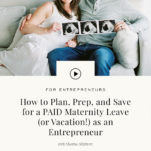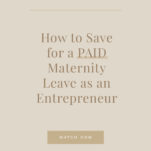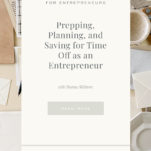Keep Reading
How to Plan, Prep and Save for a PAID Maternity leave (or Vacation) as an Entrepreneur
I know taking a month-long paid sabbatical (or a three month long paid maternity leave) can sound impossible. But I’ve now taught hundreds of my students and clients to do the same with one simple step: learning to track your high and low seasons. (I know that probably peaks your interest, so I’ll make sure […]

Paragraph
I know taking a month-long paid sabbatical (or a three month long paid maternity leave) can sound impossible. But I’ve now taught hundreds of my students and clients to do the same with one simple step: learning to track your high and low seasons. (I know that probably peaks your interest, so I’ll make sure to dig into that in more detail in another video)
But today, I’m sharing the process I’ve developed over the past 7 years for planning, prepping & saving for time off. We’ve used this same process to take month-long sabbaticals since 2014, a 3-month road trip in 2016, one year off completely in 2020 and a 3-month maternity leave in 2021!
So without further ado: how to plan, prep and save for maternity leave (or vacation) as an entrepreneur.
PLAN FOR IT!
1. Get dates on the calendar
I started the practice of annual planning in 2007 my very first full year working in finance. Each year as an office we would take a weekend away at a cabin and share our goals for the upcoming year.
Annual planning is a time out of your business to work on your business and it’s one of my favorite weeks of the year. Since starting my own company I’ve implemented this same practice and take a week off each December to plan for the upcoming year. I’ve now taught hundreds of students my annual planning process using my annual planning course & planner titled My Blueprint year.
One of the very first steps of annual planning is sitting down with your calendar and marking holidays, birthdays, and time off!
As mentioned previously, I typically plan my sabbaticals for my low seasons. The entire month of December and also one month in the summer (because a lot of my clients have their kiddos home for the summer and it’s a busier time for them as well).
For Maternity Leave this year … well, that one was kinda planned for me. I was due March 11. I decided to start my maternity leave two weeks early (just in case) → see below my recommendation for a “wind down” period. And wanted to take a full 12 weeks off with my little one. I planned to return in June. Giving myself March, April and May completely off.
2. Build in a “wind down” and “rev up” buffer period
Once you have the dates on the calendar I recommend building in “buffer” periods. For maternity leave I built in a two-week buffer prior to my due date. I wanted to have all of my work done by Friday, February 26th. I’m so glad I did because inevitably I was still wrapping things up until my due date.
I read an article once that mentioned it takes three days into vacation to stop thinking about work and a day or two before vacation ends you start thinking about work again.
That’s why I build in a wind-down and a rev-up period before and after taking time off so that I can enjoy the full length of my time away.
PREP FOR IT
1. Set your intentions
Not all time off is just for “rest”. Maternity leave clearly was for taking care of a baby. 🙂 But it’s important to set expectations.
- Will you work during your time off?
- Are you working on your business?
- Just relaxing and having fun?
- What does relaxing look like? Reading a book, sitting by the pool?
For our 3 month road-trip and also during maternity leave I actually worked 1 day a week. Since we had new students going through The Blueprint Model during both of these times, I was coaching them for live office hours once a week.
For my summer sabbaticals I typically take that time completely off. I plan trips to visit friends, a summer reading list and completely check out.
For my December sabbatical I work on my business. As mentioned I host annual planning week for my students (and use that time myself to plan for the upcoming year). We review our finances, set goals, tidy things up and just spend that time closing out the year and prepping for the upcoming year.
2. Get the help you need
The first hire I made in my business (other than contract work for brand shoots, copywriting, etc). was an assistant. In 2016, during our 3-mo road trip I didn’t have an assistant and was handling emails and student work once a week. In 2017, I hired an assistant who handled everything while I was away. It was the most disconnected / restful sabbatical I’ve ever had so I’ve stuck with that practice ever since!
For maternity leave I was coaching students through my signature course, The Blueprint Model, and planned to work each Thursday. However, I had backup speakers on call should I be in labor 😉 and unable to attend (which happened twice — on Madelyn’s due date I had a doctors appointment, and the following week Madelyn was born (she was a week late!))
I also had community members lined up to host our monthly co-working money dates so those could continue while I was away. This turned out to be something really cool for the community to have different people showing up to host these financial accountability meetups.
3. Define your boundaries
Once you set the intention of your time off and get the help you need, it’s important to define your boundaries and communicate those to your staff and clients.
For maternity leave I worked one day a week to coach students and planned to work part-time in May if I chose too.
Other boundaries I’ve decided in the past include:
- Will you still be on social media? (I find staying off social media is best to truly unplug)
- Will you answer email? From clients, from students, from staff?
- How should your team get a hold of you? (I don’t check email while I’m away so if there is an emergency they call or text me).
4. Automate everything you possibly can!
The day before my leave begins, I automate everything. I automate posts in my student Facebook groups, any posts on my public Facebook page (I no longer have Instagram but used to use Planoly to do that). My team handles Pinterest, but we use Tailwind to automate.
I always have great intentions to have new blog content ready, but I have yet to get this done. I’ve also had great intentions to have our personal finance course, Blueprint at Home, on Evergreen (meaning it’s selling through a funnel even while I’m not working). I did not get that done either.
The very last thing I do before I leave is turn on my away message. I save this for last because it’s become a mental routine that helps me “sign off” before extended time away. Think of it like a bedtime routine (something we’re working on right now with Madelyn!). Our bodies respond to a process, and for me putting that away message up last and turning off the computer signals that work is done, I can step away!
I do this before any extended time away whether it was my year off in 2020 or simply a three-day speaking event.
SAVE FOR IT
All my students and clients know what I’m about to say — it’s basically how I approach all things business. Before taking any time away, you must know your financial need! Down to the penny!
What is enough?
In The Blueprint Model we have an entire building block dedicated to “defining enough”. We do this each year to calculate our sales goal, and I also do this when planning time away.
What is enough personally? What is enough for the business? And what is enough for what I call your re-entry period?
Here’s the calculation : Personal Need + Business Overhead + Re-Entry Cost
For maternity leave we calculated three months of personal financial need (our monthly salary x 3) + 1 quarterly bonus + business overhead + an additional month of personal + business expenses. This gave me one additional month (I call this your re-entry period) so I didn’t have to jump right back into launching a course or taking on clients. I wanted to ease back in without worrying about selling something.
ps. I don’t speak to the actual costs of pregnancy, labor & delivery in this post but I’m working on another post all about paying for health care costs as an entrepreneur! Stay tuned!
—
Years ago I told one of my clients to “Make the plan, and then work the plan” and it stuck! It’s now something I teach all my students. The plan gives me comfort. Even if you aren’t a “planner” by nature, going into any amount of time away with a solid plan of how you’re going to pay for that time off will allow you to actually enjoy it. Worrying about money while you’re off just isn’t going to be restful.
Whether you’re planning for an upcoming maternity leave or just wishing you could take a week off without feeling the pressure to answer emails, I hope this process helps you plan, prep, and save for your upcoming time away.
Because time off matters! It’s not just a luxury, it’s a necessity too!
*Want to save this for later? Click the red button below to Pin it 📌 to Pinterest
July 6, 2021
Previous Post:
Next Post:



And if you found this helpful, share with your friends!